Books on making comics
Books on making comics to sell
| Cover | Title | Rating | Comment | Category |
|---|---|---|---|---|
 |
How to Draw Comics the “Marvel” Way | ☆☆☆☆☆ | The first and in some ways the best, from those who were making monthly mass-market comics in the 1960s and 70s. More than just drawing, also covering building up from stick-figures, in-frame composition, dynamic action framing, page layout, and more. (There was also a rather cheesy attempt at a making a quickie VHS video version in the 1990s, which made it to a DVD version in 2002 and can sometimes be found on YouTube). | Introduction |
 |
Working Methods | ☆☆☆☆☆ | A fine book from the team at Draw! magazine, on how top professionals actually work through their daily workflow. A $9 digital edition is here (sign-up required). (See also The Best Of Draw! in three volumes. Vol.3 goes up to issue 14 of Draw! magazine). | Introduction |
 |
Words for Pictures | ☆☆☆☆ | A sound introduction which also touches on the business side of things. | Introduction |
 |
Draw Comics Like a Pro | ☆☆☆☆ | Al Bigley’s book is pre-digital, but still a pretty good reference book for presentation styles, shading types, and angles. | Introduction |
 |
Stan Lee’s Master Class | ☆☆☆☆ | A final set of lessons from the Marvel master, summing up a lifetime of making comics. For writing see: Stan Lee’s How to Write Comics. | Introduction |
 |
How to Draw and Sell Comic Strips | ☆☆☆☆ | Alan McKenzie’s well-recommended how-to, with a British 2000AD-type perspective. Art by Steve Parkhouse. Despite the title it’s not all about four-panel newspaper strips or webcomic gag strips, but is using “strips” in its British sense – a six or eight page story to be printed as part of a weekly anthology comic like 2000AD. Make sure you get the 3rd and final edition (cover shown) from 2005. Alan kindly has a digital appendix online, with free pages that were cut from the 3rd edition. | Introduction |
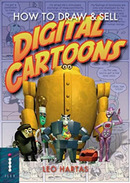
| How to Draw and Sell Digital Cartoons | ☆☆☆ | Why are these kinds of books so consistently mis-represented by publishers and cover designers? Despite the title Leo Hartas’s introductory book is not about spot or ‘gag’ cartoons, but about comic-strips and comic-books. Despite the 2004 date it takes digital really really seriously and assumes you’re working that way. It even has that ultimate rarity in such books, pages on using 3D models for comic production. Not just one or two pages, either, but 16 pages! It was thus way ahead of its time. But it’s lively, fun and still a useful introduction in 2020. Three stars, only because it’s a touch dated technically now (talks about Flash, etc). | Introduction |

| Superheroes: Joe Kubert’s Wonderful World of Comics | ☆☆☆☆ | If you judged this 1999 book by the title and cover you might think it was just a quickie Kubert artwork album, destined for the bargain spinner-racks. What the hell were the cover designers at Watson-Guptill thinking of? Because it’s actually a very fine masterclass, and especially useful for advancing traditional Bristol-board comics artists who already have some of the basics. Perspective is limited to a blissful one page only, albeit followed by about 24 pages of anatomy, and then we get another 24 interesting pages on dramatic ‘posing for emotion’. The book offers a mere two pages for layouts, sadly, and has nothing on digital. But still a good introduction for those learning to use pencils and ink. | Introduction |
 |
How to Draw Comics From Script to Print | ☆☆☆☆ | A DVD, region-locked to the USA. The process shown is also documented in print, in the magazine Write Now #8, and then Draw! #9, and also in a paperback book of the same title. It’s not about ‘how to sketch’, the pencils are already laid down in blue. Starts with pencils, inks (many good tips given), colouring in Photoshop, lettering done in Illustrator. Two-hours + script and pages in various stages. | Introduction |
 |
How Comics Work | ☆☆☆ | A sound introduction from Dave Gibbons (Watchmen), but only three stars because it’s very much pitched at bright young teens who know nothing about making comics. Recently retitled for the USA Making Comics: A Practical Guide. | Introduction |
 |
Writing and Illustrating the Graphic Novel | ☆☆☆ | A sensible and useful primer on the longer form, which will save you from making a lot of mistakes. | Introduction |
 |
Making Comics | ☆☆☆☆ | Scott McCloud gives his views on the most effective ways of storytelling in comics. Stimulating, but not a book to read first. The most practical of his various books on comics. | Writing |
 |
The Seven Basic Plots: Why We Tell Stories | ☆☆☆☆ | An outstanding and acclaimed book on plotting. There’s a lot to get through here, but it goes faster if you skip the many plot summaries. | Writing |
 |
Stan Lee’s How to Write Comics | ☆☆☆ | The master gives you “the Marvel way” of writing a gripping action-oriented comic with a human touch. | Writing |
 |
Comics Experience Guide to Writing Comics | ☆☆☆ | A good introduction to scripting for action comics. | Writing |

|
Comics Creator Prep: A Comics Course for Writers and Artists | ☆☆☆ | Mostly for writers planning out a mass-market comic, with much useful professional advice presented in the ‘class, critique, homework’ format that many art-school students will be familiar with. Also has good tips on navigating a professional career if working with large publishers. | Writing |

|
Alan Moore’s Writing For Comics | ☆☆☆ | Very short, a bit “off-the-cuff”, but still a useful and quite fun read from a comics master working at his peak in the mid-1980s. | Writing |
 |
Panel Discussions: Design In Sequential Art Storytelling | ☆☆☆☆☆ | Books on layout alone are rare as hen’s teeth, but thankfully TwoMorrows offers an outstanding book in which leading professionals talk comics layouts in a series of in-depth interviews. The book costs a small fortune in print, but there’s a digital copy here for $11 (sign-up required). | Layout |
 |
Framed Ink: Drawing and Composition for Visual Storytellers | ☆☆☆☆ | An excellent introduction, especially if you want to get into making those inky Spanish style comics. The author also has two books on comics perspective titled Framed Perspective, and another on Framed Drawing Techniques. In spring 2021 Framed Ink 2 was released, which appears to focus mainly on composition inside each comic frame. | Layout |
 |
Drawing Cutting-edge Comics | ☆☆☆☆ | Old but you could do a lot worse, and Christoper Hart offers an excellent chapter on page design and panel flow. | Layout |
 |
Hi-Fi Color for Comics: Digital Techniques for Professional Results | ☆☆☆☆☆ | Excellent. This is the only book you need on colouring comics the traditional way. It’s also pretty good on digital, but not 3D digital. If you get it used, make sure it has the CD-ROM. | Finishing |
 |
Comic Book Lettering The Comicraft Way | ☆☆☆☆☆ | Superb in-depth introduction to lettering, done as a stylish comic book of 68 pages. Comicraft, along with Blambot, are a leading maker of digital comics fonts. | Finishing |
 |
Manga Studio 5 Beginner’s Guide | ☆☆☆☆ | From 2014 and now as out-of-date as its naff cover, but it has a fine useful chapter on setting up the related and very worthy software Comic Life 3 (the chapter is free from Packt, as of 2020). There is also a Professional Manga: Digital Storytelling with Manga Studio EX (2008) but this is now very out-of-date, and the UI has changed several times since then. Indeed, the very name has changed, and the software is now called Clip Studio. | Finishing |
 |
DC Comics Guide to Digitally Drawing Comics | ☆☆☆☆ | From 2009, in 144 mostly technical pages. It assumes that you’re a traditional comic artist of 2008 who needed to speed up your workflow in the face of ever-tighter publisher deadlines. It’s thus for artists who scanned in hand-drawn art and then used early Photoshop, and who wanted the PC to help with perspective, adding backgrounds etc. Still a very useful introduction, especially if you still use Photoshop. | Finishing |
 |
Practical Poser 8: The Official Guide | ☆☆☆☆ | The software that’s widely used, but that no-one admits using. Comics made with 3D are banned from Amazon’s Comixology, which may be one reason for that. But Poser is of use for many and this book is still probably the best print introduction, after the PDF manual. Get the Third Edition. However, for Poser 11 many will now want the Learning Poser 11 DVD which is now on YouTube for free. Poser can be a vital tool for those who don’t want to spend a decade grinding through art schools and poring over anatomy books, and Poser 11 now has a Comic Book mode. | Specialist |
 |
How to Draw Noir Comics | ☆☆☆☆ | A good specialist introduction for those who want to tell stories with a ‘noir’ or ‘gothic’ look. | Specialist |
 |
Drawing Crime Noir: For Comics and Graphic Novels | ☆☆☆☆ | Another well regarded specialist introduction for those who want to tell stories with a shadowy ‘noir’ or ‘gothic’ look. | Specialist |
 |
Creative World Building and Creature Design | ☆☆☆☆☆ | A fine specialist concept development book, superb in its ideas, teaching, and presentation style. Highly recommended for world-builders. | Specialist |
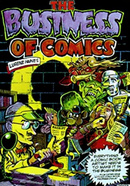 |
The Business of Comics | ☆☆☆ | From 1998, so more than a bit out-of-date now. Not least in assuming that you need to find a big publisher in order to have an audience. Still useful in getting you thinking about the money and licences, though. In the same year the same publisher also issued the poorly-reviewed Writer’s Guide to the Business of Comics. | Specialist |
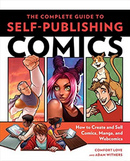 |
The Complete Guide to Self-Publishing Comics | ☆☆☆ | A chunky 240-page primer from 2014, but way over-padded with big pictures which add little. Probably written circa 2012 so slightly out-of-date now, but still useful in breaking down the process: devise characters; build their world, plot their story; write some dialogue and… stall. Get collaborators, feedback, mentors, learn to sketch anatomy, thumbnail all the page layouts. Learn about pacing, framing, expressions, body language. Realise you need to learn Photoshop, oh… and colour theory and page design. Then learn lettering, FX and balloons… so also learn Adobe Illustrator. Learn about offset printing, get a bank loan, find a printer, get distribution for your garage full of printed comics. Do merchandising and branding, build an online store. Get a convention booth, sell t-shirts and sketches, seduce sweaty nerds. So easy! | Specialist |
 |
Set the Action! Creating Backgrounds | ☆☆☆☆ | Who knew there was a Focus Press manual on drawing backgrounds for stories? It’s not one of their best, and 25 pages on perspective theory is probably not the best way to start off, but it’s nice to have if you can find it cheap. Don’t expect lush colour Disney-style backplates. The art here is all very gritty b&w British indie stuff from one artist. | Specialist |
 |
The H.P. Lovecraft Drawing Book: Learn to Draw Strange Scenes of Otherworldly Horror | ☆☆☆ | Could your comic benefit from even more tentacle-waving invaders from beyond, and their swivel-eyed earthly cultists? Then this is the book you need! | Specialist |
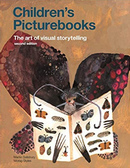 |
Children’s Picturebooks Second Edition: The Art of Visual Storytelling | ☆☆☆☆ | A sound introduction to children’s storybooks and their various types, especially useful for those who have not looked at such a book since they were ten years old. Second edition is updated a bit, but the first is free on Archive.org. | Specialist |
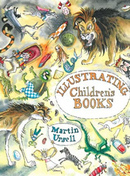 |
Illustrating Children’s Books | ☆☆☆☆ | Fills in some of the gaps in Children’s Picturebooks Second Edition (see above) | Specialist |
 |
Comics Above Ground | ☆☆☆☆ | TwoMorrows have put together a useful collection of comics pros, talking about how their techniques and approaches translate to other media. | Comics to the screen |
 |
Dr. Moebius and Mister Gir | ☆☆☆☆☆ | The famous French comics grand-master tells it like it was, in a series of long interviews. Forthcoming, but going to be awesome… so ‘five stars’ already. | Makers ‘tell it like it is’ |
 |
The Freebooters | ☆☆☆☆ | Far more than just reprints. Also an in-depth ‘making of’ and insight into the Barry Windsor-Smith process from the master himself. | Makers ‘tell it like it is’ |
 |
Japanese Comickers: Draw Anime and Manga Like Japan’s Hottest Artists | ☆☆☆ | Interviews with hot young Japanese comics makers, in English. The title is a bit misleading, as it’s not actually going to teach you to draw manga (and there are already oodles of “draw hot manga girls” books available if you go looking). There is also a Vol 2., Japanese Comickers 2. | Makers ‘tell it like it is’ |
 |
Unnatural Talent: Creating, Printing and Selling Your Comic in the Digital Age | ☆☆☆ | An indie comics maker tells all. Nice to have in this form, but most of it has been published free on his various blogs. | Makers ‘tell it like it is’ |
 |
The Encyclopedia of Cartooning Techniques | ☆☆☆ | A useful reference book, for those making comics that are more at the cartooning end of the spectrum. | Old-school and vintage |
 |
Art of Comic Book Inking | ☆☆☆ | Traditional pen-and-ink inking on boards. The next edition is said to be planning to add a chapter on digital inking. | Old-school and vintage |
 |
Foundations in Comic Book Art: SCAD Creative Essentials | ☆☆ | Still stuck in the days of dip-pens and whiteout fluid. First third is on drawing cubes and perspective! Might be good if you just bagged a place at a very traditionalist art college. | Old-school and vintage |
 |
How to Make Awesome Comics | ☆☆☆ | A good friendly all-round introduction for a keen 9 year-old. Definitely one for the next lockdown home-library. | Introductions for kids |
 |
The DC Comics Guide to Pencilling Comics | ☆☆ | A very basic book, seemingly aimed at a bright but clueless 11 year old. A very poor section on layouts, and generally rather weak teaching. Still, if you can find it cheap then it’s probably fine as a Christmas stocking-filler. There are also shelf-companions, the DC Comics Guide To Inking Comics and DC Comics Guide to Coloring and Lettering Comics, which may not be as basic as this. | Introductions for kids |
 |
Comic Book Design: The Essential Guide to Creating Great Comics. | ☆☆☆ | Despite the publisher’s all-conquering title, librarians appear to put this in the middle-childhood section. Apparently intended to offer young teens a comprehensive survey of recent superhero and other visual approaches — but without including any DC comics and no manga. For a manga how-to book suitable for teens see the book The Complete Idiot’s Guide To Drawing Manga. | Introductions for kids |
|
Need coaching to help make your comic? Try Digital Art Live’s Visual Narratives Academy. There’s a 30-day money-back guarantee, if it’s not for you! |
